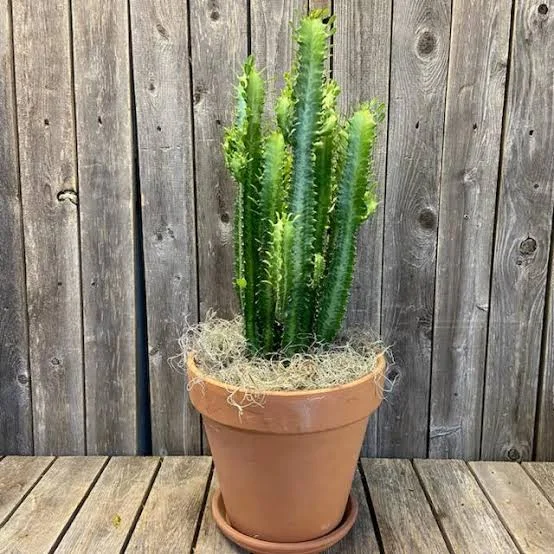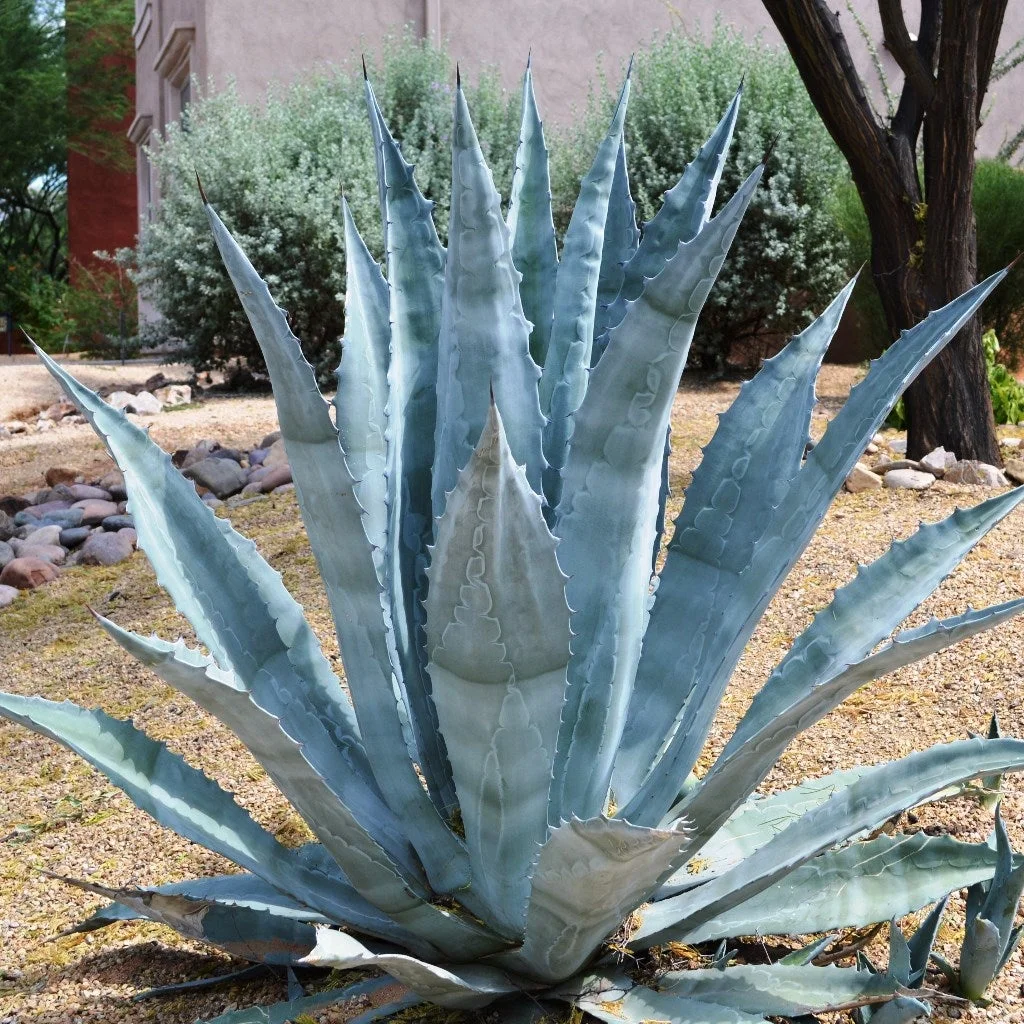Are you looking for plants that grow straight up and fill your spaces quickly? Here we have some tall growing succulents just for you
Succulents are low-maintenance plants with thick and fleshy leaves that can store water. They are priced because of their drought tolerance and beautiful foliage. But what if you want some tall succulents that can grow straight up and quickly? From Candelabra spurge to Century plant, we will cover the top 12 vertically growing succulents so that you can make informed choices according to your preferences.

Tall Succulents That Grow Straight Up
1. Candelabra Spurge
Botanical name: Euphorbia ammak ‘Variegata’
Height: 15 to 20 feet tall
USDA Zones: 9-11
Euphorbia ammak Variegata has tall, four-winged stems in shades of green and cream. This Saudi Arabian native can be propagated through seeds or stem cuttings. During summer, it produces small, green, and yellow flowers at the top of the stem. Candelabra Spurge can grow up to 20 feet and is a true showstopper for any space.
2. Madagascar Palm

Botanical name: Pachyopodium lamerei
Height: upto 15 feet tall
USDA Zones: 9-11
The Madagascar Palm is one of the largest palm species that grows naturally in Southwest Madagascar. This spiny succulent features swollen stems and beautiful flowers. It grows into a metallic grey trunk with some leaves at the top and flowers only after about 10 years. Although this succulent can tolerate full sun, it will need frequent feedings and waterings in hot weather.
3. Elephant Bush
Botanical name: Portulacaria afra
Height: 15 feet tall
USDA Zones: 10-11
Elephant bush is a perennial succulent from South Africa, where it can grow upto 15 feet outdoors. This is due to the plant’s defense mechanism, as it is a popular food source for elephants. However, growing inside, it rarely goes above 3 to 5 feet and is easy to care for. You can also use its foliage in salads and soups to impart a sour flavor.
4. Eve’s Needle

Botanical name: Austrocylindropuntia subulata
Height: upto 13 feet tall
USDA Zones: 9-11
This succulent can grow as tall as 13 feet outdoors and has long, fleshy leaves on cylindrical stems. These leaves are commonly used as vegetables in some parts of Mexico and South America. Eve needle performs well in neutral and alkaline soils but can also withstand saline and shallow soils.
5. African Milk Tree
Botanical name: Euphorbia trigona
Height: upto 9 feet tall
USDA Zones: 9-11
The African milk tree is an architectural succulent with three-sided columnar stems and spiny branches. It performs best in extended light exposure and can tolerate dry and winter conditions. If you are growing it indoors, place your pot in the sunniest place, and do not forget to turn it weekly. This will ensure that all sides get adequate light.
6. Joshua Tree

Botanical name: Yucca brevifolia
Height: upto 40 feet tall
USDA Zones: 6-10
This large succulent is named after the biblical figure “Joshua,” as the 19th-century Mormons believed that its outright limbs pointed them in the right direction. It usually consists of a single trunk that stretches between 3 and 5 feet before branching out. The leaves are greyish-green with pointed tips and blooms between February and late April.
7. Ocotillo
Botanical name: Fouquieria splendens
Height: upto 20 feet tall
USDA Zones: 7-11
Ocotillos are adaptable desert plants that grow throughout the Sonoran and Chihuahuan deserts. They perform well in various soils and can live up to 60 years. Ocotillos bloom in spring and produce bright red flowers, which are an important food source for hummingbirds.
8. Wild grape

Botanical name: Cyphostemma juttae
Height: 6 feet
USDA Zones: 9-11
This South African native can grow as tall as 6 feet and produces greenish-yellow flowers throughout the summer. Its stem is exceptionally long, with leaves arranged like petals. This slow-growing succulent can survive in little water and is an excellent choice for containers and open gardens.
9. Snake Plant

Botanical name: Dracaena trifasciata
Height: upto 8 feet tall
USDA Zones: 9-11
This popular houseplant can thrive in a variety of light conditions and is relatively easy to care for. It can grow upto 8 feet in the wild; but only reaches 2.5 to 3 feet while growing inside. Snake plant bloom in the spring and produce white flowers that look like honeysuckle. Apart from its ornamental appeal, it can also remove harmful toxins such as benzene and xylene from indoor environments.
10. Aloe

Botanical name: Aloe Vera
Height: upto 3 feet tall
USDA Zones: 8-11
Although Aloe Vera doesn’t get as tall as the other succulents on this list, it makes up for it with its functionality and appeal. It’s upright-growing spiky leaves are filled with a magical gel that instantly soothes sunburns. This plant performs well in warm weather and cannot handle frost. Therefore, it is a good idea to bring it inside to ensure it comes back each year.
11. Century Plant
Botanical name: Agave spp.
Height: upto 8 feet tall
USDA Zones: 8-10
Agave is a perennial succulent with fleshy leaves and sharp thorns. It doesn’t need much irrigation either, as it directly absorbs moisture from the air through a process called CAM (Crassulacean Acid Metabolism). As a houseplant, it grows up to 4 feet and flowers only once in its entire lifetime.
12. Saguaro

Botanical name: Carnegiea gigantea
Height: 40 to 60 feet tall
USDA Zones: 8-11
Our list of the best succulents that grow straight up is incomplete without the mighty saguaro. It is native to the Sonaran desert and is one of the tallest cacti in the world. This plant performs well in soils with proper drainage and good light conditions. It is not frost-tolerant but can survive for over 100 years with proper care.
Whether you opt for the mighty saguaro or the functional aloe, these succulents can surely transform any indoor or outdoor space. Which succulent are you going to add into your garden, or have you tried any of these plants before? Start your growing journey and keep us posted with your experience and photos. Happy growing!











One comment on “12 Succulents That Grow Straight Up”